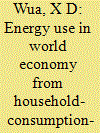| Srl | Item |
| 1 |
ID:
166298


|
|
|
|
|
| Summary/Abstract |
An overview for energy use within the world economy as reflected by the Eora database for 2012 is conducted by means of household-consumption-based multi-regional input-output analysis that is parallel to existing energy accounting frameworks. From a household-consumption-based perspective, the energy use for Mainland China economy is only around half of that for the United States. The world's trade volume of energy use associated with consumer products is quantified, which is over one-fifth of the global total energy consumption. Mainland China is revealed to be with the largest trade deficit of energy use, in magnitude up to the summation of the trade imbalance of all other major economies. Heavy industry products shipped to Europe & Eurasia, Asia Pacific and North America account for nearly 80% of Mainland China's exports of energy use. To safeguard sustainable energy use, the developed economies are suggested to further strengthen their comparative advantages in those high value-added goods or services while developing economies such as Mainland China are supposed to alter the trade patterns by a transition of economic structure.
|
|
|
|
|
|
|
|
|
|
|
|
|
|
|
|
| 2 |
ID:
168674


|
|
|
|
|
| Summary/Abstract |
Over the past few decades, Thailand has been one of the highly open economies and one of the most successful countries in applying the export-led growth model. At the same time, carbon dioxide (CO2) emissions released in Thailand tripled between 1990 and 2015. To examine how international trade plays a role in shaping Thailand’s CO2 emissions inventory, we compare emissions under both production-based and consumption-based accounting over 1990–2015 and disaggregate total CO2 emissions into traded and non-traded parts. We also use a multi-regional input-output database for performing a structural decomposition analysis (SDA) to investigate the factors contributing to changes in CO2 emissions. We find that Thailand continually stood out as a net carbon exporting country. CO2 embodied in exports accounted, on average, for 40% of domestically produced emissions. Our SDA results suggest that traded and non-traded emissions grew mainly due to increasing per-capita consumption in Thailand and abroad. The retarding effect from energy efficiency improvement was significant but not sufficient to reduce emissions.
|
|
|
|
|
|
|
|
|
|
|
|
|
|
|
|